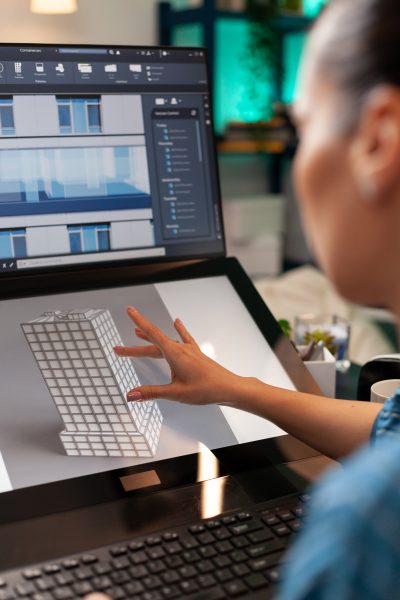In a McKinsey survey, 64 percent of respondents believe that AEC (Architecture, Engineering, and Construction) technology will yield higher returns compared to investments in other industry sectors. At the heart of this technological revolution is artificial intelligence (AI). AI is a game-changer, enhancing design precision and streamlining construction processes like never before. In this blog, we dive into the multifaceted impact of AI on design and construction, showcasing its transformative potential and the innovative ways it is reshaping architectural practices. Discover how AI is revolutionizing the industry, driving efficiency, and opening up new frontiers in architectural design and construction management.
How AI Transforms Design and Construction

AI in Architectural Design
Enhanced Design Precision
One of the most significant contributions of AI to architecture is its ability to enhance design precision. Traditional design methods often involve a considerable amount of trial and error, which can be time-consuming and costly. AI algorithms, however, can analyze vast amounts of data and generate designs that meet specific criteria with remarkable accuracy.
BizForce’s tech-savvy architects are at the forefront of this AI revolution. They leverage advanced AI-powered software to optimize building layouts for energy efficiency, natural light distribution, and structural integrity. By analyzing environmental data, such as sunlight patterns and wind flow, AI can suggest design modifications that improve a building’s sustainability and performance. This level of precision not only ensures better outcomes but also reduces the need for extensive revisions, making the design and construction process more efficient and cost-effective.
Generative Design

Generative design is another groundbreaking application of AI in architecture. This approach involves using AI algorithms to create multiple design iterations based on predefined parameters. Architects input constraints such as spatial requirements, materials, budget, and aesthetic preferences, and the AI generates a variety of design options that meet these criteria.
Generative design in architectural design and construction enables architects to explore a broader range of possibilities in a shorter amount of time. It also encourages innovative solutions that might not have been considered through traditional design processes. By leveraging AI’s computational power, architects can push the boundaries of creativity and develop unique, optimized designs.
AI in Construction
Project Planning and Management
AI is also revolutionizing the construction phase of the architectural designs. One of the key areas where AI is making a significant impact is project planning and management. AI-powered tools can analyze project data, identify potential risks, and suggest strategies to mitigate them. This proactive approach helps in minimizing delays, cost overruns, and other common challenges in construction projects.
For example, AI algorithms can predict equipment failures by analyzing historical data and current usage patterns. This allows construction managers to schedule maintenance activities before a breakdown occurs, reducing downtime and ensuring smoother project progression. Additionally, AI can optimize resource allocation by predicting labor and material requirements, thereby improving overall project efficiency.
Construction Automation
Automation is another area where AI is transforming construction. Robotics and AI-powered machinery are increasingly being used to perform repetitive and labor-intensive tasks on construction sites. These technologies not only enhance productivity but also improve safety by reducing the need for human workers to operate in hazardous environments.
Robotic bricklayers, for instance, can lay bricks faster and with greater precision than human workers. Similarly, AI-powered drones are used for site inspections, surveying, and monitoring progress. These drones can capture high-resolution images and generate 3D models of the construction site, providing valuable insights into the project’s status and identifying potential issues early on.
AI-Driven Building Information Modeling (BIM)

Building Information Modeling (BIM) is a digital model representing both a building’s physical and functional attributes. AI is enhancing BIM by making it more intelligent and predictive. AI algorithms can analyze BIM data to identify design clashes, optimize building performance, and simulate various scenarios to predict outcomes.
For instance, AI can simulate the impact of different materials on a building’s energy efficiency, helping architects make informed decisions. It can also predict how a building will perform under different environmental conditions, allowing for better planning and risk management. By integrating AI with BIM, professionals in design and construction can create more accurate, efficient, and sustainable buildings.
Sustainable Architecture
Sustainability is a critical concern in modern architecture, and AI is playing a crucial role in promoting green building practices in architectural design and construction management. AI-powered tools can analyze environmental data to optimize building designs for energy efficiency, water conservation, and reduced carbon footprint.
For example, AI can optimize HVAC (heating, ventilation, and air conditioning) systems to reduce energy consumption while maintaining comfort levels. It can also analyze water usage patterns to suggest water-saving measures. By leveraging AI, architects can design buildings that are not only aesthetically pleasing but also environmentally responsible.
Challenges and Future Directions for AI in Design and Construction
While the benefits of AI in architecture are substantial, there are also challenges to consider. Ensuring the availability of clean, reliable data is essential for the successful implementation of AI in architecture, and a significant concern is the requirement for high-quality data. Additionally, there is a need for professionals in design and construction to develop new skills to work effectively with AI technologies. This includes understanding how AI algorithms work, interpreting their outputs, and integrating AI tools into existing workflows. Continuous education and training will be crucial in bridging the gap between traditional practices and AI-driven approaches.
As AI technologies continue to advance, we can expect even more sophisticated applications that further enhance design precision, streamline construction processes, and promote sustainability. For instance, AI could enable real-time design adjustments based on changing environmental conditions or user preferences. It could also facilitate more collaborative and integrated project delivery models, where all stakeholders work together seamlessly in design and construction.
Conclusion
AI is undoubtedly transforming the architecture and construction industry. By enhancing design precision, enabling generative design, improving project planning and management, automating construction tasks, and promoting sustainability, AI is revolutionizing how buildings are designed and constructed. While there are challenges to overcome, the potential benefits of AI are immense, paving the way for a future where architecture is more innovative, efficient, and sustainable. As AI continues to evolve, it will undoubtedly play an increasingly integral role in shaping the built environment of tomorrow.
Work with BizForce’s expert architects and engineers today to experience the cutting-edge benefits of AI-driven design and construction. Our team leverages advanced AI-powered software to deliver precise, sustainable, and innovative solutions tailored to your specific needs. Contact us here.
